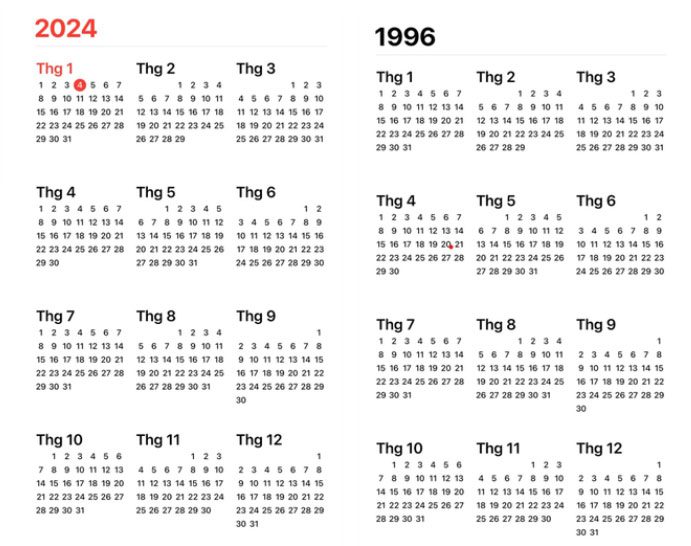Observing the calendar for the year 2024, one can notice that the order of the days throughout the year is remarkably identical to that of the year 1996. According to experts, this is a matter of arithmetic and convention in the Gregorian calendar.
The Calendar for 2024 Matches 1996 in an Unbelievable Way
On January 4th, many social media accounts and groups continuously shared images comparing the Gregorian calendar of 2024 with that of 1996. Notably, if you pay attention, whatever day of the week it was in 1996, the corresponding day in 2024 is the same; in simpler terms, both calendars are identical.

The 2024 calendar is very similar to 1996.
Posts discussing this topic quickly garnered significant attention, with many receiving tens of thousands of likes, comments, and shares across various social media platforms. The coincidence between the calendars of 1996 and 2024 intrigued and delighted many, leading to questions about why this alignment occurs.
Mr. Đặng Vũ Tuấn Sơn from the Vietnam Astronomy and Cosmology Association mentioned that many people have been sharing their curiosity about why the order of the days in 2024 perfectly matches that of 1996. This is simply a matter of arithmetic and convention within the Gregorian calendar.
Everyone knows that each week has 7 days, and each year has 365 days (or 366 in the case of a leap year with February 29). When you divide 365 by 7, you get a remainder of 1, while 366 divided by 7 gives a remainder of 2. Therefore, if you compare any given day between two consecutive years, and there are no leap days (February 29) in between, the day of the week for the following year will advance by one day. For instance, January 1, 2024, is a Monday, which means that January 1, 2023, was a Sunday, and January 1, 2022, was a Saturday—no need to open a calendar to know this.
Thus, if this pattern continues, after 7 years, January 1 will again fall on the same day of the week compared to the reference year. However, due to the involvement of leap years (considered every 4 years, except for 2100 which is divisible by 4 but not a leap year), the actual cycle is 5 or 6 years (depending on whether 1 or 2 leap days occur in between).
The case that many people are referring to here is the years 1996 and 2024. January 1 of these two years is separated by 10,227 days. This number is divisible by 7, so they coincide in the order of the week. Additionally, both years 1996 and 2024 are leap years, so all remaining days of the year are also aligned.
For non-leap years, in this century, there have been 3 years—2001, 2007, and 2018—where January 1 also started on a Monday, and all remaining days of those years are the same. The gap between 2007 and 2018 exists because in 2012, which marks 5 years from 2007, January 1 had advanced to a Sunday; however, since that year was a leap year, January 1, 2013, fell on a Tuesday.
“You can also see that due to the difference between leap and non-leap years, the years 2001, 2007, and 2018 cannot be ‘completely identical’ to 1996 and 2024. The differences arise when crossing through leap days.
A specific example: February 28, 2018, was a Wednesday, and that same date in 2024 is also a Wednesday. However, 2018 was not a leap year, so the next day, March 1, 2018, was a Thursday, while in 2024, which is a leap year, March 1 will fall on a Friday.“, Mr. Đặng Vũ Tuấn Sơn explained.
Interesting Coincidences Between the Lunar and Solar Calendars
“In general, this is entirely a coincidence based on human calendar conventions, not a strange alignment. Additionally, there are also interesting coincidences between the solar and lunar years that people can explore further,” Mr. Sơn stated.
Essentially, the principle of date calculation in ancient Eastern cultures was similar to that of Western cultures. Today, we understand that a day is the time it takes for the Earth to complete one rotation on its axis. However, ancient people were unaware of this astronomical rule and calculated days based on the position of the Sun in the sky. The benchmark chosen was when the Sun is at its highest point at noon. The period between two consecutive noons is considered one day.
In the West, the day is divided into 24 hours, with 12:00 being the time of noon. This is also the international time used in administration that we are familiar with today.
In the East, a day is divided into 12 periods, named after the 12 branches of the zodiac (Rat, Ox, etc.), where the Rat period lasts from 11 PM the previous night to 1 AM the following day. Therefore, many resources suggest that the lunar calendar day is one hour earlier than the solar calendar day. The noon time in the lunar calendar corresponds to the Horse period, which lasts from 11 AM to 1 PM. The midpoint of this period that corresponds to noon in the solar calendar is when the Sun is at its highest point, called “chính ngọ.”
The months in the lunar calendar are based on the cycles of the Moon in the sky. The Moon is Earth’s natural satellite, moving in an orbit around the Earth with a cycle of 27.32 days. However, because the Earth also moves around the Sun, it takes additional time for the Moon to return to its original position when viewed from Earth, making the observed lunar cycle approximately 29.53 days. This cycle is referred to as a lunar month. In ancient Eastern cultures, this lunar month was used as the length of a calendar month. The first day of each month begins on the day of the new moon, commonly known as “điểm sóc.” This is the point when the entire dark side of the Moon faces the Earth, making it invisible at night.
Because the lunar month cycle is 29.53 days rather than a whole 29 or 30 days, the new moon does not fall at a fixed hour. Thus, if the new moon occurs late on the first day of the lunar month, the next new moon will be after the 30th day of that month, resulting in a month of 30 days. In contrast, if the new moon occurs early on the first day, the next new moon will appear after 29.53 days, leading to a month without a 30th day, referred to as a short month.


















































